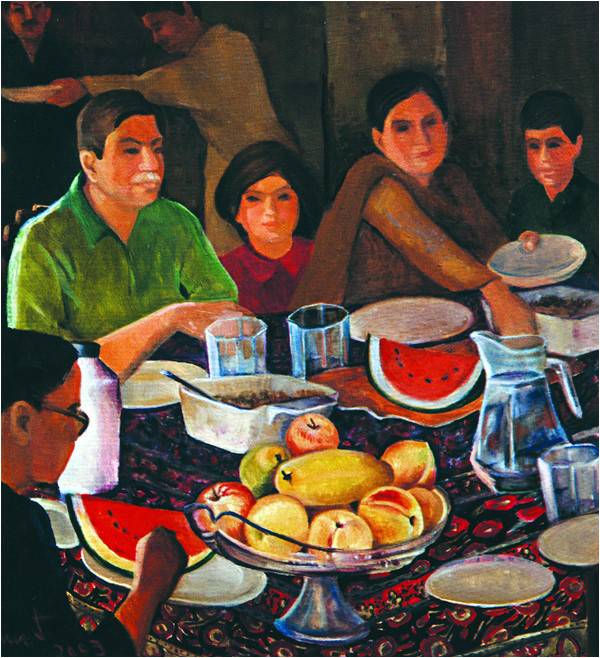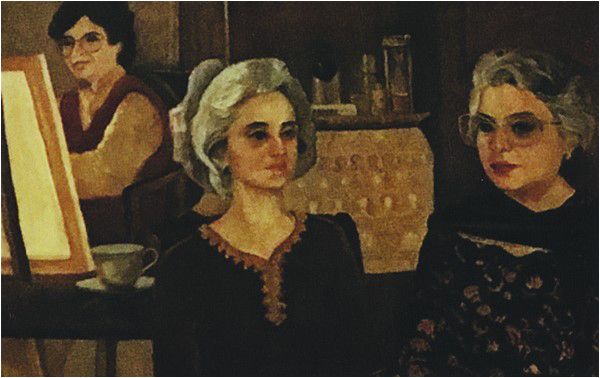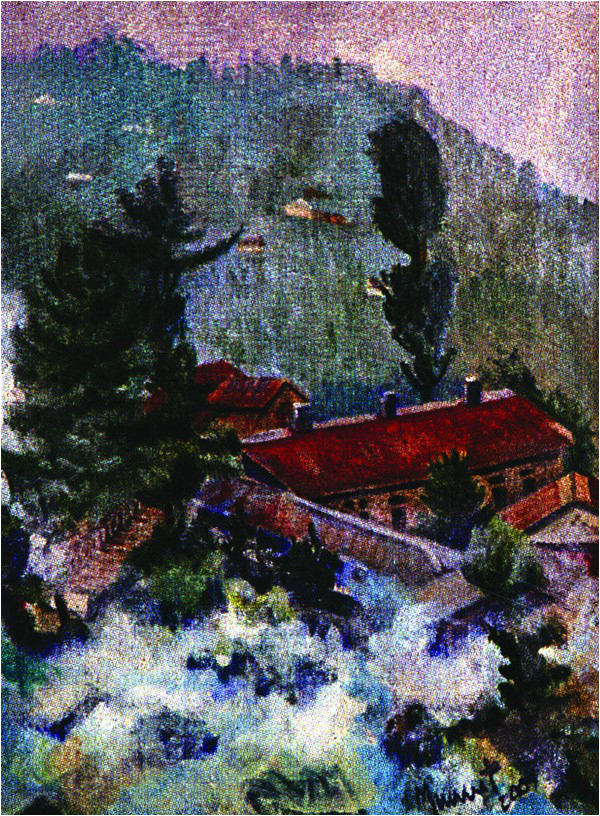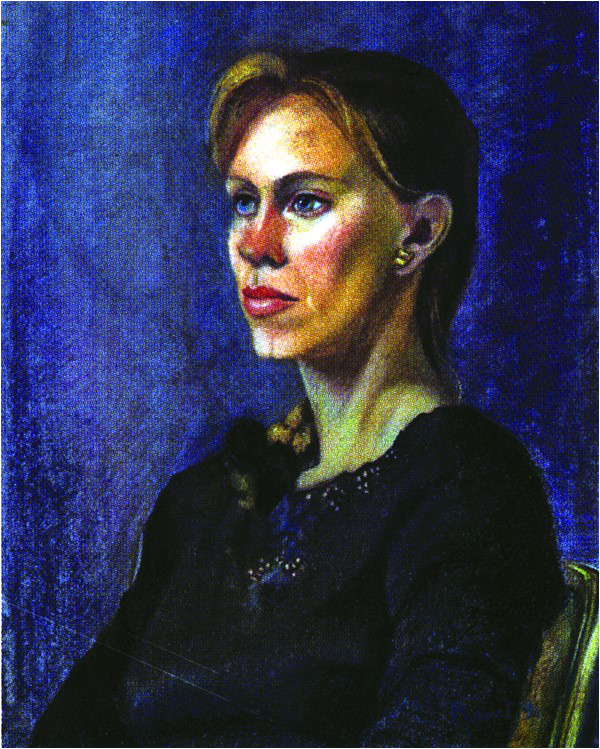
While walking in a field of wheat, rice, cotton or any other crop, one often wonders about the idea of newness and permanence. Sheaves or grains glowing against the strong sunshine in the heat of April or September, of course, are new and fresh, but essentially these are not different from millions which grew in the last seasons or years. How is it that one particular plant can be distinct from innumerable others that sprouted in the same land, or distant regions, yet belonging to same species?
Do we, as human beings share the same fate in the eye of a Supreme Being? Diverse, difficult and conflicting individuals may appear hardly different from the rows of grains moving to and fro along with the morning breeze. Perhaps. So the exchange of ideas, pride at personal traits, projection of a particular mind-set: all can be activities as frivolous as distinguishing one grain of wheat from the second, or one shrub from the next, or one mango tree from the rest.
In that scenario what is the role of an artist? A person who is there to capture not appearance but the essence: the truth behind entities which transform with shifts in light, changes of position and cycles of seasons. So the artist who reaches the essence - the soul of things (no matter if those are living beings or mere objects) - to some extent is able to portray what takes place beyond the lens of our eyes.
Or beyond the lens of a camera: as happens in the art of Dr. Musarrat Hasan. Her paintings defy any dependence on a mechanical tool to record resemblances. Instead, she seeks to portray the reality beyond momentary existence. Her portraits of family, friends, acquaintances and other people offer a glimpse into the psychological self of those who posed for her. Through her gallery of immortals (because it is only art that guaranties posterity), her paintings depict how a man, woman, a couple or a group think while modelling for her. On the basis of a common fallacy, people often assume that a living being may behave like a bunch of flowers or a cluster of houses when painted, without having any awareness of his/her likeness being recorded. Or in other words, they might presume he/she is devoid of any feeling, sensation or sensitivity: merely still life!
Hasan, in an important gesture, reverts back to the lives of beings, so one can associate with her models warmly, even those that we see from their back (for instance Mian Ijazul Hassan, who because of his posture, and surroundings is unmistakably recognised) or part of a large setting, such as a landscape. In her compositions, she selects people close to her: family members, relatives, colleagues and so on, but her way of painting them turns them eternal and captures that which is internal. And this is only because Hasan manages to capture an instant, a moment, a movement, a gesture that defines her models. Milan Kundera in his novel Immortality writes that each human being possesses a particular gesture which stays with him/her, and becomes an identity –an identification mark for him/her. Musarrat Hasan, in her portraits, regardless of whether the subject is her mother-in-law, her daughter-in-aw, a visiting artist from another city or a model who posed for many years, sees them for the first time through the eyes of her brush and discovers something unusual in them. And this makes them familiar personages and special and endearing characters.

In fact, in some of her work, human beings are not disjointed from their surroundings at all: be those physical or emotional. Families engaged in common pursuits, passing time leisurely at a hill station, gathered around a dinner table or just sitting close to each other, all reflect the shared feelings which are disseminated through small – but not insignificant – gestures, observed by Musarrat Hasan in her canvases. Perhaps the unavoidable and lasting impact of these canvases comes from the artist’s decision to create a balance, or rather a bridge, between the artist’s personality and the personalities of her subjects.
As is the case with every social interaction and discourse, most of us are engaged in a competition to conquer others. If a painter is portraying a human figure, what is he/she making: his/her own vision or the objective reality in front of him/her? This, for some an insignificant matter, is a crucial concern to a number of artists, because in some cases it is the persona of the artist that takes over, resulting in misrepresentation. But in the art of Hasan, one discovers a fine balance between the artist’s self and those of her subjects. Her models do not convey the contours of their faces, bodies or surroundings only, but the depth of their personalities, which may not be recognised (as facial features) but can reveal the artist’s passion for her models. Her works are not merely the compositions of body but are about distinct personalities, appreciated by the painter and becoming the very reason for painting them in the first place.

At her retrospective recently held at the Zulfi Art Gallery, Lahore, - a rare occasion to see the lifelong work of a dedicated painter - one can observe the artist’s oeuvre in terms of treating her subject matter: not as a mere technical or formal prop, but a person who holds great importance for her regardless of his/her link with her or his/her significance, status or services. In her art they all emerge loved by the painter, who discovers something new, exciting and eternal in her models.
A number of still-life paintings, shown at the same exhibition, appear to be part of the same legacy one of love for human beings. Objects such as flowers on a table affirm a man/woman’s passion for beauty out of the mundane. In fact, her act of connecting with the very basis of humanity, materiality and nature converges them to a single point. Her sensitive brush strokes unite and bind diverse subjects and multiple views, and blend scattered hues into one, unified and uniform universe. All of that depends upon and germinates from an elementary activity: how an artist, by placing his/her marks on a surface, denotes the outside world as well as the inner self.

In the case of Musarrat Hasan, it is difficult to distinguish between what is beyond the personality (eyes) of the painter or what exists in actuality (a detached account of people, scenes and items) because both merge and converge to make a synthesis that will keep on enchanting viewers due to its simplicity and sincerity, even after the earlier and initial contact with the painter’s models or her surroundings ends. Much like the stems of wheat and rice, which will remain alive, fluttering, fascinating,enticing and enriching till the end of the world!
Do we, as human beings share the same fate in the eye of a Supreme Being? Diverse, difficult and conflicting individuals may appear hardly different from the rows of grains moving to and fro along with the morning breeze. Perhaps. So the exchange of ideas, pride at personal traits, projection of a particular mind-set: all can be activities as frivolous as distinguishing one grain of wheat from the second, or one shrub from the next, or one mango tree from the rest.
In that scenario what is the role of an artist? A person who is there to capture not appearance but the essence: the truth behind entities which transform with shifts in light, changes of position and cycles of seasons. So the artist who reaches the essence - the soul of things (no matter if those are living beings or mere objects) - to some extent is able to portray what takes place beyond the lens of our eyes.
One can associate with her models warmly, even those that we see from their back
Or beyond the lens of a camera: as happens in the art of Dr. Musarrat Hasan. Her paintings defy any dependence on a mechanical tool to record resemblances. Instead, she seeks to portray the reality beyond momentary existence. Her portraits of family, friends, acquaintances and other people offer a glimpse into the psychological self of those who posed for her. Through her gallery of immortals (because it is only art that guaranties posterity), her paintings depict how a man, woman, a couple or a group think while modelling for her. On the basis of a common fallacy, people often assume that a living being may behave like a bunch of flowers or a cluster of houses when painted, without having any awareness of his/her likeness being recorded. Or in other words, they might presume he/she is devoid of any feeling, sensation or sensitivity: merely still life!
Hasan, in an important gesture, reverts back to the lives of beings, so one can associate with her models warmly, even those that we see from their back (for instance Mian Ijazul Hassan, who because of his posture, and surroundings is unmistakably recognised) or part of a large setting, such as a landscape. In her compositions, she selects people close to her: family members, relatives, colleagues and so on, but her way of painting them turns them eternal and captures that which is internal. And this is only because Hasan manages to capture an instant, a moment, a movement, a gesture that defines her models. Milan Kundera in his novel Immortality writes that each human being possesses a particular gesture which stays with him/her, and becomes an identity –an identification mark for him/her. Musarrat Hasan, in her portraits, regardless of whether the subject is her mother-in-law, her daughter-in-aw, a visiting artist from another city or a model who posed for many years, sees them for the first time through the eyes of her brush and discovers something unusual in them. And this makes them familiar personages and special and endearing characters.

The lasting impact of these canvases comes from the her decision to create a bridge between the artist's personality and the personalities of her subjects
In fact, in some of her work, human beings are not disjointed from their surroundings at all: be those physical or emotional. Families engaged in common pursuits, passing time leisurely at a hill station, gathered around a dinner table or just sitting close to each other, all reflect the shared feelings which are disseminated through small – but not insignificant – gestures, observed by Musarrat Hasan in her canvases. Perhaps the unavoidable and lasting impact of these canvases comes from the artist’s decision to create a balance, or rather a bridge, between the artist’s personality and the personalities of her subjects.
As is the case with every social interaction and discourse, most of us are engaged in a competition to conquer others. If a painter is portraying a human figure, what is he/she making: his/her own vision or the objective reality in front of him/her? This, for some an insignificant matter, is a crucial concern to a number of artists, because in some cases it is the persona of the artist that takes over, resulting in misrepresentation. But in the art of Hasan, one discovers a fine balance between the artist’s self and those of her subjects. Her models do not convey the contours of their faces, bodies or surroundings only, but the depth of their personalities, which may not be recognised (as facial features) but can reveal the artist’s passion for her models. Her works are not merely the compositions of body but are about distinct personalities, appreciated by the painter and becoming the very reason for painting them in the first place.

At her retrospective recently held at the Zulfi Art Gallery, Lahore, - a rare occasion to see the lifelong work of a dedicated painter - one can observe the artist’s oeuvre in terms of treating her subject matter: not as a mere technical or formal prop, but a person who holds great importance for her regardless of his/her link with her or his/her significance, status or services. In her art they all emerge loved by the painter, who discovers something new, exciting and eternal in her models.
A number of still-life paintings, shown at the same exhibition, appear to be part of the same legacy one of love for human beings. Objects such as flowers on a table affirm a man/woman’s passion for beauty out of the mundane. In fact, her act of connecting with the very basis of humanity, materiality and nature converges them to a single point. Her sensitive brush strokes unite and bind diverse subjects and multiple views, and blend scattered hues into one, unified and uniform universe. All of that depends upon and germinates from an elementary activity: how an artist, by placing his/her marks on a surface, denotes the outside world as well as the inner self.

In the case of Musarrat Hasan, it is difficult to distinguish between what is beyond the personality (eyes) of the painter or what exists in actuality (a detached account of people, scenes and items) because both merge and converge to make a synthesis that will keep on enchanting viewers due to its simplicity and sincerity, even after the earlier and initial contact with the painter’s models or her surroundings ends. Much like the stems of wheat and rice, which will remain alive, fluttering, fascinating,enticing and enriching till the end of the world!

